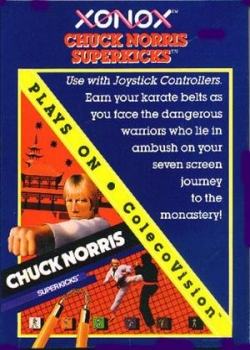Gameplay
In Chuck Norris Superkicks, Norris must reach a monastery within six minutes. The player controls Chuck Norris on a vertically-scrolling overworld. Norris must walk along a path, and if he steps in the grass, time is lost at a faster rate. Warriors ambush Norris as he walks, causing him to enter battle.
While in battle, Norris faces three enemies, one at a time, who run back and forth and throw shurikens. If an enemy hits Norris, he is knocked down and vulnerable to attacks. If a shuriken hits him, the player loses time and Norris is sent back to the start of the path. Norris has three moves: punch, kick, and block which can be used by pressing the attack button while moving the stick in a certain direction. Pressing the button without moving the stick will make Norris do nothing. The block protects Norris from shurikens, while the punches and kicks must be chosen depending on which part of the enemy's body is exposed.
After defeating some enemies, Norris reaches a checkpoint and a split in the path, along with getting a new belt and an extra minute on the timer. At the next checkpoint, accessible after fighting more enemies and going further down the path, Norris unlocks a new attack that replaces the block and works against every enemy.
At the monastery, Norris fights multiple ninjas, who can turn invisible. The game ends when time runs out.
This page is based on this
Wikipedia article Text is available under the
CC BY-SA 4.0 license; additional terms may apply.
Images, videos and audio are available under their respective licenses.
